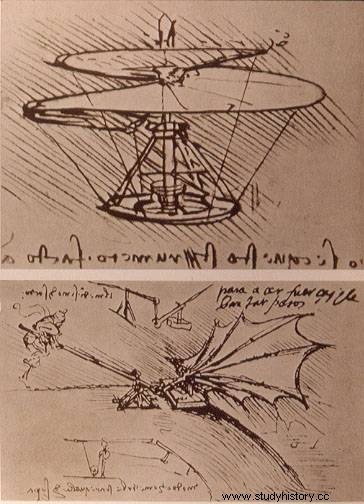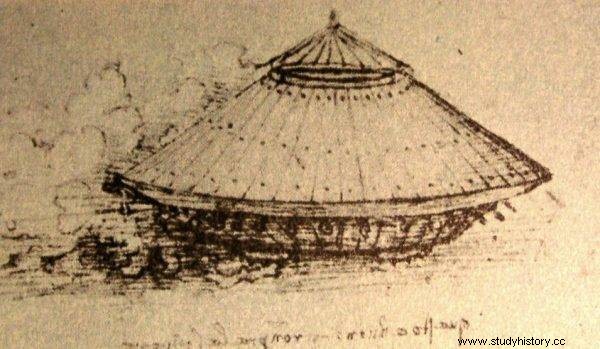Leonardo da Vinci is considered the archetype of the Renaissance man. He painted, sculpted, wrote, counted, discovered and played musical instruments. He gained fame thanks to the paintings "Mona Lisa" and "The Last Supper". He was also appreciated by the designs and sketches of various types of machines and everyday objects.
Born on April 15, 1452, Leonardo is said to be ahead of his time and some of his inventions seem timeless. Skeptics do not believe them, arguing that more than 500 years ago, one man could not have come up with enough innovative ideas. Conspiracy theories, which are in abundance, claim that da Vinci was a time-traveler or emissary of some alien, highly advanced civilization. This is how they explain the ideas and technological solutions of the Renaissance constructor. Which of his works can actually aspire to be "ahead of the time"?
Flying machines
Man has always dreamed of flying. Already in mythology, Daedalus constructed the wings on which his son, Icarus, flew. Made of bird feathers, stuck together with wax, they turned out to be imperfect, and an attempt to fly on them ended in the young man's death. Leonardo, whose cradle was about to fly a kite, believed in destiny, and this bird was to be a clue . In the initial phase of work on the flying machine, he relied on the analysis of bird wings and movements.

Helicopter and hang glider sketched by Leonardo da Vinci
- I built a structure of wood covered with silk. On top of it I put on bird feathers and airy net. However, this idea turned out to be wrong. It was not an appropriate idea to follow the birds. Wings modeled on the wings of a bat turned out to be a much better idea. (…) Thanks to this, it is easier to take to the air, because without holes, the air cannot pass through the wings. But this idea also turned out to be wrong.
On the basis of the sketches he had drawn, he built models of paper. He glued them with wax. It is not known whether he personally tried to take to the air. P in 1506 on Monte Ceceri he was to organize a flight test for one of his flying machines, at the controls of which was Tomasso Masini . Unfortunately, no documents confirming those events have survived. Moreover, it is more often said that the whole story is one big myth.
Leonardo da Vinci realized with time that a man is too heavy and too weak physically to rise into the air only with the help of wings and hand movement. That is why his drawings include a design that resembles modern helicopters. Only that the solutions used in it would not allow it to lift up:it was assumed that the rotor and the hull of the machine were to rotate in the opposite direction.

The text was created, among others based on Christopher Macht's book "Confession by Leonardo da Vinci", which has just been released by Bellona Publishing House.
In the end, the great inventor gave up work on creating a flying machine. Has he not surrendered hastily? In October 2002, British girl Judy Leden became a test pilot, flying a glider built on the basis of his 500-year-old drawings. Only materials to which da Vinci would have access were used - a linen sail with a black poplar and bamboo frame, connected with leather straps and hemp string. The attempt was successful.
Parachute
While Leonardo da Vinci could talk about failure in terms of floating with the help of mechanisms, the case of falling was different. The constructor is considered to be the creator of the parachute. In the book "The Confession of Leonardo da Vinci" we find a description of an innovative solution:
- The principle of its operation is very simple. The idea is to attach a few lines to something similar to a pyramid, with the tip pointing up. A falling man would hold to these lines, and this pyramid would slow down the fall. As a result, such a slow fall would not crash to the ground.
The project turned out to be successful, which was proved after many years. In 2008, Swiss paratrooper Olivier Vietti-Teppa jumped from a height of 650 meters with a parachute made according to sketches and directions from Leonardo da Vinci and landed unscathed. Eight years earlier, a similar attempt was made by the British parachute jumper Adrian Nicholas. He also finished his jump safe and sound.
War Machines
The first tanks, marked Mark I, were used in combat in 1916 by the British in the Battle of the Somme as support for the infantry. Da Vinci had thought of similar constructions much earlier. The first mention of a similar vehicle is in a letter from Leonardo da Vinci to Ludovico Sforza - then Duke of Milan - dated 1482-1483. In his letter, da Vinci offered the Sovereign of Milan his services as a military engineer, including a series of proposals for the construction of war devices, including a combat vehicle:armored (resembling a turtle), equipped with cannons whose task was to throw stones. This is how he summarized his vision:
"I can also build covered, safe and impregnable cars that, with their gun fire, will be able to break through enemies, and those, however numerous, will not be able to able to attack them. They will be able to follow the chariot on foot, in great numbers, unharmed and unhindered ... "
Later, around 1487, Leonardo captured this conceptual design in a sketch. However, there is no evidence that a prototype of the vehicle was built, probably due to technical limitations of its construction.
What if someone decided to produce the Ala Leonardo combat vehicle? In fact, the vehicle's blueprints contained an error:the cranks were moving in opposite directions. Many historians argue that the oversight was intentional and intended to discourage interested people from building the vehicle. In the book "The Confession of Leonardo da Vinci" you can find a mention of this:

Later, around 1487, Leonardo captured this conceptual design in a sketch. However, there is no evidence that a prototype of the vehicle was built
- Especially in my projects, I introduced minor bugs to protect myself in a situation where they would be taken over by the enemy. This was the case, for example, with the design of the fighting machine. I have consciously made some modifications in my engravings. Thanks to this, if the invention were implemented according to my drawings, it would have a problem with moving. This armored vehicle would move sideways or backwards immediately. This is a bug that I consciously introduced into the project. That way, if it fell into the wrong hands, it would be useless.
Da Vinci also designed a huge, nearly thirty-meter crossbow, which was to wreak havoc among enemy troops. In addition, in his notes there were catapult drawings, guns. He is also credited with creating a circular lock.
Other projects
The number of inventions attributed to Leonardo is impressive. Among the more interesting, there are also equipment for the extraction of groundwater, a swing bridge and bearings. One of the less known, but interesting ones, was the construction of the measuring device, or if you like - the rangefinder. With his help, da Vinci made a precise architectural measurement of the city of Imola, which was commissioned by Cesare Borgia.
- I still remembered what I called a rangefinder. It was also a cart. He, in turn, operated on the principle that when the wheels in the cart made a full turn, one ball fell into a special container. Therefore, it was enough to travel a certain distance with this cart and count the balls and then multiply by the circumference of the wheel to know what the distance is.

The text was created, among others based on Christopher Macht's book "Confession by Leonardo da Vinci", which has just been released by Bellona Publishing House.
Throughout his life, the visionary made about six thousand pages of notes. Most of them related to the technical aspects. Due to limitations, most of the solutions presented in them have not been implemented. The theory was not put into practice. It does not change the fact that nowadays many people try to create devices of the great designer based on these plans.
Bibliography:
- M. Aszkiełowicz, Inventions of Leonardo da Vinci , Katowice 2013
- Movie: Leonardo da Vinci - the all-round genius , 2018
